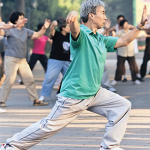Amy Price, a patient editor at The BMJ who has chronic pain due to past trauma, wrote a commentary accompanying the study. When she first started tai chi, Price writes, “I could only do ten minutes, three times a week, with constant supervision, because of memory and balance problems. Gradually, over about six weeks, my balance improved and this reduced anxiety and increased strength in my broken body. The ingrained philosophy of tai chi is to leverage force rather than resist it, and I still use this strategy regularly to manage pain.”3
In a telephone interview, Price tells Reuters Health that tai chi does not help everyone, but that she has seen it help people with neurodegenerative diseases including Parkinson’s, multiple sclerosis and early-stage dementia.
“It helps your system learn to work together naturally again,” she adds. “For me it was really helpful, and it has a kind of grace to it. You don’t have to be coordinated like you would to do dancing or something like that.”
References
- Wang C, Schmid CH, Fielding RA, et al. Effect of tai chi versus aerobic exercise for fibromyalgia: comparative effectiveness randomized controlled trial. BMJ. 2018 Mar 21;360:k851. doi: 10.1136/bmj.k851.
- Wang C. Time to rethink exercise for fibromyalgia care. BMJ. 2018 Mar 21.
- Price A. The unintended consequences of tai chi for fibromyalgia. 2018 Mar 21.


